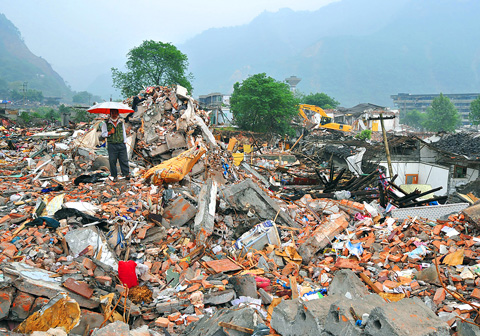A big aftershock rattled southwest China yesterday, killing at least one person and injuring 400, state media reported, nearly a fortnight after a big quake killed tens of thousands in the same area.
More than 70,000 houses were toppled during yesterday’s tremor in Sichuan Province, state TV reported. The 5.8 magnitude aftershock was epicentered 40km west-northwest of Guangyuan, the US Geological Survey said.
At the same time hundreds of troops carrying explosives were trekking through the area, attempting to reach a “quake lake” that threatened a secondary disaster.

PHOTO: AFP
Concerned by a rise in the water level of a giant lake at Tangjiashan, authorities have been seeking to blast a hole in the barrier before it bursts and causes a flashflood. Thousands have been evacuated below the lake as a precaution.
Chinese Premier Wen Jiabao (溫家寶), who believes the overall death toll from the main quake could exceed 80,000, has said the main concerns are now secondary disasters like flooding and landslides, epidemics and providing shelter for the millions of displaced.
State TV earlier reported that an 80-year-old partially paralyzed man was the longest known survivor to date. He was pulled alive from the rubble on Friday, 266 hours after the 7.9 magnitude quake hit.
The man was rescued in Mianzhu City, where he had been trapped under a collapsed pillar of his house. He had survived after being fed by his wife, the TV report said.
The biggest concern among the dozens of quake lakes is the one at Tangjiashan, which rose 1.93m yesterday to 723m, Xinhua said.
“The relief work for Tangjiashan quake lake is now at critical stage,” Vice Minister of Water Resource E Jingping (鄂竟平) told a news conference in Beijing.
“The daunting difficulty in treating a quake lake is its unpredictability — its formation and when it could burst,” he said.
But a military expert near the wrecked town of Beichuan said the lake did not pose an immediate threat.
“This is a precautionary step in case there is rain over the coming days. The dam is far from overflowing yet, but we need to release water in case the predicted rains come,” said the People’s Liberation Army officer, surnamed Liu.
Forecasts of rain added to worries yesterday about relief efforts to house the millions of people left homeless by the earthquake.
The government warned that heavy rain was on the way, possibly hampering work to get temporary shelters up to house the estimated 5 million who lost their homes in Sichuan Province.
The State Meteorological Bureau said yesterday that parts of Sichuan would suffer “heavy and even in some areas torrential rains” later yesterday and today.
The bureau warned of “possible mudslides” caused by the heavy rain.
Rescuers were also trying to reach 24 coal miners who officials said were trapped in three mines by the disaster, though they didn’t know if the miners were alive.
Xinhua news agency said that China’s customs office had streamlined entry procedures for relief materials and rescue personnel. It said that on Saturday 47 batches of overseas relief materials, including tents and medicine had arrived in quake-hit areas. Aid is being sent by large and small countries.
Also See: Games organizers shorten torch’s trip through Tibet

The Ministry of Foreign Affairs (MOFA) yesterday said it is closely monitoring developments in Venezuela, and would continue to cooperate with democratic allies and work together for regional and global security, stability, and prosperity. The remarks came after the US on Saturday launched a series of airstrikes in Venezuela and kidnapped Venezuelan President Nicolas Maduro, who was later flown to New York along with his wife. The pair face US charges related to drug trafficking and alleged cooperation with gangs designated as terrorist organizations. Maduro has denied the allegations. The ministry said that it is closely monitoring the political and economic situation

Conflict with Taiwan could leave China with “massive economic disruption, catastrophic military losses, significant social unrest, and devastating sanctions,” a US think tank said in a report released on Monday. The German Marshall Fund released a report titled If China Attacks Taiwan: The Consequences for China of “Minor Conflict” and “Major War” Scenarios. The report details the “massive” economic, military, social and international costs to China in the event of a minor conflict or major war with Taiwan, estimating that the Chinese People’s Liberation Army (PLA) could sustain losses of more than half of its active-duty ground forces, including 100,000 troops. Understanding Chinese

UNRELENTING: China attempted cyberattacks on Taiwan’s critical infrastructure 2.63 million times per day last year, up from 1.23 million in 2023, the NSB said China’s cyberarmy has long engaged in cyberattacks against Taiwan’s critical infrastructure, employing diverse and evolving tactics, the National Security Bureau (NSB) said yesterday, adding that cyberattacks on critical energy infrastructure last year increased 10-fold compared with the previous year. The NSB yesterday released a report titled Analysis on China’s Cyber Threats to Taiwan’s Critical Infrastructure in 2025, outlining the number of cyberattacks, major tactics and hacker groups. Taiwan’s national intelligence community identified a large number of cybersecurity incidents last year, the bureau said in a statement. China’s cyberarmy last year launched an average of 2.63 million intrusion attempts per day targeting Taiwan’s critical

‘SLICING METHOD’: In the event of a blockade, the China Coast Guard would intercept Taiwanese ships while its navy would seek to deter foreign intervention China’s military drills around Taiwan this week signaled potential strategies to cut the nation off from energy supplies and foreign military assistance, a US think tank report said. The Chinese People’s Liberation Army (PLA) conducted what it called “Justice Mission 2025” exercises from Monday to Tuesday in five maritime zones and airspace around Taiwan, calling them a warning to “Taiwanese independence” forces. In a report released on Wednesday, the Institute for the Study of War said the exercises effectively simulated blocking shipping routes to major port cities, including Kaohsiung, Keelung and Hualien. Taiwan would be highly vulnerable under such a blockade, because it